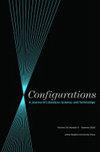Genesis Effects: 20世纪80年代计算机图像中的生长行星
IF 0.3
4区 文学
Q3 HISTORY & PHILOSOPHY OF SCIENCE
引用次数: 0
摘要
摘要:本文考察了20世纪80年代出现的一种关于计算机生成行星的论述,当时计算机图形学从业者对他们所谓的“自然现象模拟”产生了兴趣。这些图形工程师帮助开发了现实主义的标准和建模和模拟的方法,这些标准和方法得到了科幻版模仿的支持,现实主义是对现实的延伸,而不是对现实的再现。通过计算机生成的《星际迷航2:可汗之怒》和《2010:我们接触的一年》的图像,以及数学家Benoit Mandelbrot的插图,我展示了行星的表征是如何被关于行星“生长”的科幻故事预先化的。这影响了关于粒子系统、分形景观和其他程序生成图形模拟方法的学术讨论,并帮助授权了一种将物理和“视觉”相结合的认识论——也就是说,以非物理为基础的模拟作为一种接近自然现象的现实渲染的手段。本文章由计算机程序翻译,如有差异,请以英文原文为准。
Genesis Effects: Growing Planets in 1980s Computer Graphics
ABSTRACT:This article examines a discourse about computer-generated planets that emerged in the 1980s, just as computer graphics practitioners became interested in what they called the "simulation of natural phenomena." These graphics engineers helped to develop standards of realism and methods for modeling and simulation that were supported by a science-fictional version of mimesis, with realism as an extension of, rather than a reproduction of, reality. Through the computer-generated imagery of Star Trek II: The Wrath of Khan and 2010: The Year We Make Contact, and illustrations by mathematician Benoit Mandelbrot, I show how representations of planets were prethematized by science fiction stories about planets being "grown." This influenced scholarly conversations about particle systems, fractal landscapes, and other procedurally generated graphical simulation methods, and helped to authorize an epistemology combining physical and "visual"—that is, non-physics-based—simulation as a means of getting closer to the realistic rendering of natural phenomena.
求助全文
通过发布文献求助,成功后即可免费获取论文全文。
去求助
来源期刊

Configurations
Arts and Humanities-Literature and Literary Theory
CiteScore
0.50
自引率
0.00%
发文量
33
期刊介绍:
Configurations explores the relations of literature and the arts to the sciences and technology. Founded in 1993, the journal continues to set the stage for transdisciplinary research concerning the interplay between science, technology, and the arts. Configurations is the official publication of the Society for Literature, Science, and the Arts (SLSA).
 求助内容:
求助内容: 应助结果提醒方式:
应助结果提醒方式:


